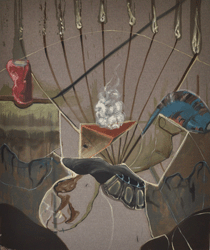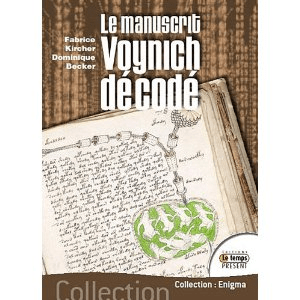Given that (a) I’m somewhat overstretched right now (imagine Doctor Who fighting Daleks and Cybermen with the Tardis and his underpants on fire, and you’re 10% of the way there) and (b) I’ve got a whole heap of Voynich-related bits to work through, it’s time for another Voynich miscellany post. Yes, just like last year’s one. Only better! 🙂
Firstly, the Voynich theories
Don’t inhale too deeply!
* If you first read about the Voynich too late at night through a haze of smoke, you can end up with some pretty hazy theories. Like this one, where the nine-rosette page is “a map of the general functioning of the multiverse. If you look closely, you can see eyeballs. This represents the observer effect, and the craziest part of all.” Moreover, “the manuscript is a guide for how to extract entheogenic substances or mixtures from plants, or to graft them together to create novel substances. I believe the author learned the theory of everything from a psychedelic trip, and that’s why there’s a clear galaxy picture.” Like, yeah, it all makes sense now, cool.
* The Federation of Light would like to let us know that the Voynich Manuscript was accidentally lost by “a child from Orion ( peacefull breed ) in training as a botanist“. Which is, of course, a great weight off all our minds. 🙂
* Here’s a channelling session with an entity called “Master Ruanel” who gets asked about the Voynich Manuscript. He thinks it’s nonsense! That was easy… now to solve the Euro crisis. 🙂
* Oh, and there’s a claimed Voynich decryption (“BE A RAS RABBLE”, really) on YouTube, if you like that kind of thing. Not my bag, sorry!
* Might the Voynich Manuscript actually be visual music? Composer and sonic contemplator Dan Wilson wonders so… it’s true that projecting cymatics back into the Quattrocento seems a bit of a stretch to me, but you may have a different opinion!
…and now all the other Voynichiana:
* Here’s a nicely composed photograph by Espen Gleditsch entitled “Voynich Manuscript 2009”, which basically looks like my own desk half the time (except I haven’t got a copy of Levitov’s book here).
* Pineal’s “A Key To Voynich” MP3 is available for download on Amazon. £0.89 buys you over 7 minutes of pulsing electronic dance stuff!
* However, that’s as nothing compared to “Manuscript 408”, the first track on Ice Dragon’s “Tome of the Future Ancients”, whose meatily metallic slice of bass-heavy doom rrrrock weighs in at over 10 minutes, and at whatever price you name. Basically, if you have long enough hair to flick and a virtual plectrum to air-guitar with, this could well be The Ultimate Voynich SoundTrack For Your Life:-
Words written down so long ago / In a language already gone
From hand of scribe / Down through the pen / And marked into vellum
Cloaked in darkness / The secret remains / Hidden from us for all time
The ravings of a madman / Or learned scholar / We may never know why
Brought forth while in possession / Of knowledge from other realms
Through supernatural process / One may obtain / That which is withheld
The scryer, the seer / Can talk to beings / Who remember the ancient days
When men were more / When they weren’t lost / In their mathematical ways
32 gone, 240 remain / Torn out by a dark mage
Who knew of the power / Held within / They are in use to this day
Herbal / Astronomical / Biological / Cosmological / Pharmaceutical
When all combine / Madness of the mind / Destroy all life / And reset time
When all combine / Madness of the mind / Destroy all life / And reset time
* E6 Town Hall Hoursong has released Volume 8 Voynich Manuscript, containing a number of Voynich-themed tracks. It’s all a bit experimental, you might like it, who knows?
* Here’s a nice picture by artist Barbara Suckfüll, more than a tad reminiscent of the Voynich’s nine-rosette page. (Click on it to see more detail).
* My favourite link of the day is to Rigid Hips Stockholm Motorcycle Space Sect (I kid you not), who writes that “The herbal, medical, astronomical/astrological, balneological and mechanical secrets of the Voynich Manuscript is basicly what keeps me going, and ofcourse the live albums the Ramones did in the late 70’s. […] The Ramones didn’t play all downstrokes, that’s a myth, if you analyse most their live albums Johnny and DeeDee goes 16 downstrokes / 4 up and down / 16 downstrokes / 4 up and down, and for some reason that is really important to me.” Now that’s someone with a finger on their own pulse, which I can really admire. But the real question is: would Rigid Hips like Ice Dragon? 🙂



